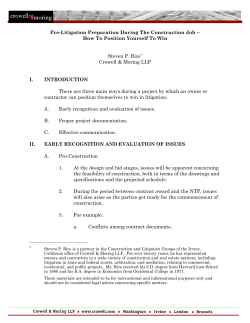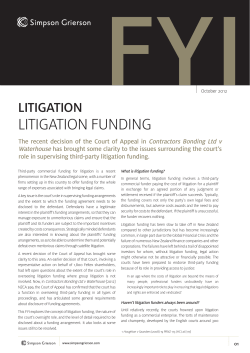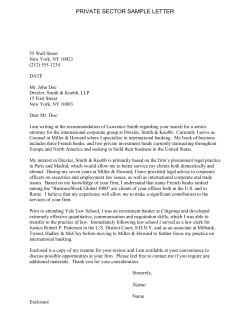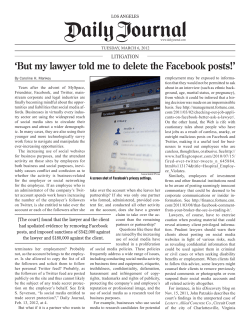
How To Reduce the Risks of U.S. Litigation:
How To Reduce the Risks of U.S. Litigation: A Guide for Foreign Businesses Steven C. Bennett The foreign business client might not fully appreciate the extent of the litigation risk in the U. S., so it is up to counsel to advise the client about the risks and to take steps to avoid them. Steven C. Bennett is a partner with Park Jensen Bennett LLP in New York City and teaches at Hofstra Law School and New York Law School. In modified form, an earlier version of this article appeared in Mealy’s International Asbestos Liability Report and Mealy’s International Arbitration Report. FOR BUSINESSES HEADQUARTERED outside the United States, but with some involvement in U.S.‑related commerce, the risks of becoming involved in civil litiga‑ tion in U.S. courts require careful attention. This article reviews steps that foreign businesses may consider to help reduce those risks. The steps outlined are neither man‑ datory nor exhaustive. Each business must adopt its own structures and processes to meet its particular needs and circumstances. UNIQUE RISKS IN U.S. LITIGATION • Foreign businesses are particularly good targets for U.S. lawsuits and threats of litigation. They may not fully understand the U.S. business and legal milieu, and underestimate the dangers of a lawsuit.1 They also may not appreciate the As one English judge famously put it: “As a moth is drawn to the light, so is a litigant drawn to the United States.” See Smith Kline & French Lab. Ltd. v. Bloch, [1983] 1 W.L.R. 730, quoted in Paul D. Carrington, Moths To The Light: The Dubious Attractions Of American Law, 46 Kansas L. Rev. 673, 686 (1998) (“[A]s a moth is drawn to the light, aggrieved plaintiffs afforded a choice will often be wise to elect an American forum as the place in which their grievances are heard.”); see also In re Air Crash Near Peixoto De Azeveda, 574 F. Supp.2d 1 The Practical Lawyer | 23 24 | The Practical Lawyer value in the U.S. climate of carefully drafted, Amer‑ ican-style contract protections. They often do not bring an American lawyer into their planning ear‑ ly enough to help reduce the risk of lawsuits and claims against the foreign party. The U.S. litigation system includes features un‑ known, or rare, in other nations. Many of these features can affect the risks presented to businesses confronting U.S. litigation.2 Jury Trial Under the United States Constitution and state constitutions, either party to a civil lawsuit may de‑ mand a trial by jury in most types of litigation.3 The parties may also agree to have a judge try the case without a jury. Parties sometimes waive their right to jury trial to permit an early trial, or where they are concerned that a lay jury may not fully under‑ stand the evidence and arguments. The fact that average citizens decide issues of liability and damages in complex commercial cases, often involving potentially high monetary awards, gives the process a certain amount of unpredictabil‑ ity. This unpredictability can promote settlements because companies often prefer a settled, known result to the potential for a seemingly random jury verdict. 272, 278-79 (E.D.N.Y. 2008) (“it is a fact that plaintiffs will almost always select a forum in which they believe they will maximize their recovery, as long as they have a reasonable chance of remaining in the forum, and that forum is often within the U.S.”). See generally Anne Tucker Nees, Making a Case for Business Courts: A Survey and Proposed Framework to Evaluate Business Courts, 24 Ga. St. L. Rev. 477 (2012); Mary Kay Kane, Dispute Resolution in the United States: Concerns and Opportunities in an Era of Globalization of Securities Markets, 14 Hastings Int’l & Comp. L. Rev. 405 (1990-1991). 2 See U.S. Constitution, Seventh Amendment (civil cases), Sixth Amendment (criminal cases); see also Taylor v. Louisiana, 419 U.S. 522 (1975) (jury trial is safeguard against arbitrary use of power); Strauder v. West Virginia, 100 U.S. 303 (1880) (jury trial embodies judgment by peers). 3 June 2014 Discovery Another key factor is the significant amount of discovery available in U.S. litigation.4 Discovery is the process by which each side investigates (discov‑ ers) what evidence (information) the other side and non-party witnesses may possess concerning issues in the lawsuit. The standard of relevance is quite broad and limits on discovery typically depend on a showing of “undue” burden. A court may order that confidential documents be produced for the litigation, but not made publicly available. The discovery process also allows lawyers to take wide-ranging depositions of an opponent’s employees, and non-party witnesses. In a deposi‑ tion, a lawyer for a party asks questions of the wit‑ ness, typically in a conference room at the lawyer’s offices, with no judicial officer present. The testimo‑ ny is given under oath and a stenographer records everything the witness says. Whether an officer or employee of a foreign company can be required to travel to attend a depo‑ sition in the U.S. depends on a number of factors.5 Even where personal jurisdiction over the foreign defendant clearly exists, counsel often successfully argue that the plaintiff ’s attorney should be re‑ quired to travel to the defendant’s home country to take the deposition, to reduce litigation burden. Parties may also stipulate to such limitations. Class Actions In federal court, and in most state courts, a plaintiff may seek to sue as a representative of a large class of people, all injured or damaged in sim‑ Proposals to apply a specific “proportionality” standard in federal discovery are under consideration. See generally Thomas Y. Allman, Rules Committee Adopts “Package” Of Discovery Amendments, 13. Dig. Discov. & E-Evid. 200 (2013). 4 See e.g., Community Federal Sav. & Loan Ass’n v. FHLBB, 96 F.R.D. 619 (D.D.C. 1983) (requiring showing that senior company employee had “unique” personal knowledge of facts); Baine v. Gen. Motors Corp., 141 F.R.D. 332, 334-35 (M.D. Ala. 1991) (same). 5 Reducing Risk of U.S. Litigation | 25 ilar ways by the actions of a defendant.6 If certain procedural conditions appear, the law will allow one or more representatives to sue on behalf of the whole class, without all other members of the class formally becoming parties to the lawsuit. Punitive Damages In certain kinds of cases, juries may award pu‑ nitive damages, intended to punish (and deter) the defendant for certain types of improper conduct. Such damages must comport with constitutional requirements of due process.7 Some states, more‑ over, place limits on a jury’s ability to award puni‑ tive damages, while in other states punitive damage awards are more common.8 Certain statutes, such as the federal Racketeer Influenced and Corrupt In 2005, Congress enacted the Class Action Fairness Act (“CAFA”), 28 U.S.C. §§ 1332(d), 1453, 1711-1715, in reaction to widespread reports of “abuses of the class action device” in state courts. See S. Rep. No. 109-14, at 10-27 (2005). CAFA has succeeded in moving many large class actions from state to federal court, even though some judicial opinions may have made removal of particular cases more difficult than Congress had intended. See Howard M. Erichson, Fairness to Whom? Perspectives on the Class Action Fairness Act of 2005, 156 U. Pa. L. Rev. 1593, 1612-14 (2008). 6 See, e.g., State Farm Mut. Auto. Ins. Co. v. Campbell, 538 U.S. 408 (2003) (limiting reprehensibility review to harms with a specific nexus to the individual plaintiff; ruling that single-digit ratio of punitive to compensatory awards applies in most cases; and barring the use of irrelevant out-of-state conduct to support a punitive award); Cooper Industries, Inc. v. Leatherman Tool Group, Inc., 532 U.S. 424 (2001) (requiring de novo appellate review of constitutionality of punitive damages awards); BMW of No. America v. Gore, 517 U.S. 559 (1996) (setting out guideposts for analysis of the constitutionality of punitive awards under the Due Process Clause of the Fourteenth Amendment). 7 Caps on punitive damages, special standards (such as a requirement of “clear and convincing evidence” to support punitive damage awards) and other procedural devices to limit awards of punitive damages are all part of a larger movement in the U.S. toward “tort reform.” See generally Myungho Paik, Bernard S. Black, David A. Hyman & Charles Silver, Will Tort Reform Bend the Cost Curve?, 9 J. of Empirical Leg. Studies, 173 (2012); Thomas A. Eaton, David B. Mustard & Susette M. Talarico, The Effects of Seeking Punitive Damages on the Processing of Tort Claims, 34 J. of Legal Studies 202 (2005). 8 Organizations (“RICO”) law,9 and parallel state laws, permit recovery of “treble” damages in cer‑ tain cases. Contingency Fees Unlike lawyers in most of the world, U.S. law‑ yers may represent a client on a contingency fee ba‑ sis.10 Instead of billing for professional time spent as the case progresses, or a flat fee, the lawyer’s fee is “contingent” on recovery after trial or by settle‑ ment. The lawyer receives a percentage of the re‑ covery (typically one-third). If the case is lost, the lawyer gets nothing.11 No “Loser Pays” Rule With certain statutory exceptions,12 the U.S. rule is that each party to a lawsuit pays its own at‑ torneys’ fees. Generally, there is no “loser pays” rule as in many countries. This rule may be varied by agreement of the parties. See 18 U.S.C. §§ 1961, et. seq. The RICO law, originally designed to suppress organized crime, has become a significant tool in civil litigation. See generally Pamela H. Bucy, RICO Enterprises: The Mob And Fraud, 85 Temple L. Rev. 99 (2012). 9 See Barnes v. Alexander, 232 U.S. 117 (1914) (upholding onethird fee). The specific terms of the contingency fee agreement generally control. See, e.g., U.S. Denro Steels, Inc. v. Lieck, 342 S.W. 3d 677, 682 (Tex. Ct. App. 2011) (where agreement called for fee based on any “judgment” awarded, no recovery by counsel where settlement of arbitration included dismissal of parallel lawsuit). 10 Critics of the contingency fee system abound. See generally Deborah L. Rhode, Frivolous Litigation And Civil Justice Reform: Miscasting The Problem, Recasting The Solution, 54 Duke L.J. 448, 467 (2004) (claiming that contingency fees, among other factors, cause the American justice system to be “excessively expensive, . . . inaccurate and inconsistent”). 11 See Hensley v. Eckerhart, 461 U.S. 424, 429, (1983) (requiring “express” statutory provision to shift attorney’s fees in litigation). Courts also have inherent authority to award attorney’s fees and costs for “bad faith” actions in litigation. See Chambers v. NASCO, Inc., 501 U.S. 32, 45-46 (1991); see also Vaughn v. Atkinson, 369 U.S. 527 (1962). Under Rule 11 of the Federal Rules of Civil Procedure, moreover, federal courts may award fees where “frivolous” litigation occurs. 12 26 | The Practical Lawyer Federalism As a federal republic, the U.S. does not embody a unitary legal system. Instead, two distinct, yet of‑ ten overlapping, sets of laws may apply: (1) federal law, promulgated by the national government; and (2) state law enacted by one or more of the fifty states. Businesses operating in the U.S. may find themselves confused as to whether state or federal law controls their activities. Generally, businesses must be prepared to comply with both state and federal law, where the laws do not conflict. If they do conflict, then federal law generally controls be‑ cause the U.S. Constitution makes federal law “the supreme law of the land.”13 Similarly, two court systems operate in the U.S.—the federal judiciary and the court system of each of the fifty states. The federal constitution lim‑ its the subject matter jurisdiction of federal courts, generally, to cases “arising under” federal law (known as “federal question” jurisdiction) or cases involving state law where the parties are citizens of different states (known as “diversity of citizen‑ ship” or simply “diversity” jurisdiction), reserving all other cases to the state courts.14 If both sides of See U.S. Constitution, Art. VI, Cl. 2 (“This Constitution, and the Laws of the United States which shall be made in pursuance thereof; and all treaties made, or which shall be made, under the authority of the United States, shall be the supreme law of the land; and the judges in every state shall be bound thereby, anything in the constitution or laws of any state to the contrary notwithstanding.”). The process of determining whether state law has been “preempted” by federal law sometimes requires careful parsing of the provisions of federal law. Compare Brueswitz v. Wyeth LLC, 131 S. Ct. 1068 (2011) (text and structure of national vaccination statute preempted state design defect claims) with Williamson v. Mazda Motor of America, Inc., 131 S. Ct. 1131 (2011) (no preemption where no indication that preemption was a “significant objective of federal regulation”). 13 See U.S. Constitution, Art. III, Sec. 2 (“the judicial Power shall extend to all Cases, in Law and Equity, arising under this Constitution, the Laws of the United States, and Treaties made, or which shall be made, under their Authority; . . . to Controversies between two or more States; —between a State and Citizens of another State; —between Citizens of different States;—between Citizens of the same State claiming Lands 14 June 2014 a lawsuit include foreign parties, no “diversity” ap‑ pears, and the matter may be heard in state court.15 If a defendant has been sued in state court, but the case arises under federal law or involves parties of diverse citizenship, the defendant may “remove” the case from state to federal court. This “remov‑ al” procedure can be a powerful tool for businesses because federal civil procedure rules can often be more favorable to defendants.16 Extra-Territorial Application of U.S. Law The American legal system operates under the general presumption that U.S. laws will not apply beyond U.S. territorial jurisdiction unless Congress clearly intends such extraterritorial reach.17 Thus, for example, where the plaintiff, the defendant, and some allegedly tortious conduct lack any connec‑ tion to the U.S., the Supreme Court has resisted application of U.S. law.18 Yet, where either “the wrongful conduct had a substantial effect in the United States or upon United States citizens,” or some portion of the wrongful conduct “occurred in the United States,” a U.S. court may apply U.S. law to a foreign defendant.19 under Grants of different States, and between a State, or the Citizens thereof, and foreign States, Citizens or Subjects.”) See Universal Licensing Corp. v. Paola del Lungo S.p.A., 293 F.3d 579, 581 (2d Cir. 2002) (no diversity jurisdiction “where on one side there are citizens [of a State] and aliens and on the opposite side there are only aliens”). 15 The right of removal of cases does not appear in the U.S. Constitution. It is, however, a right extended by Congress since the early days of the Republic. The right to remove a case from state to federal court is vested exclusively in the defendant. 28 U.S.C. § 1441(A); 28 U.S.C. § 1446(a). See also Shamrock Oil and Gas Corp. v. Sheets, 313 U.S. 100, 61 S.Ct. 868 (1941). 16 See Morrison v. National Australia Bank, 130 S. Ct. 2869 (2010); E.E.O.C. v. Arabian American Oil Co., 499 U.S. 244 (1991). 17 See Kiobel v. Royal Dutch Petroleum Co., 133 S.Ct. 1659 (2013) (presumption against extra-territorial application of U.S. law applies to claims under Alien Tort Statute). 18 See Morrison, 130 S. Ct. at 2879 (citing SEC v. Berger, 322 F.3d 187, 192-93 (2d Cir. 2003)); see also Psimenos v. E.F. Hutton & Co., 722 F.2d 1041, 1045 (2d Cir. 1983) (describing tests for proper extra-territorial application of U.S. law). 19
© Copyright 2025





















